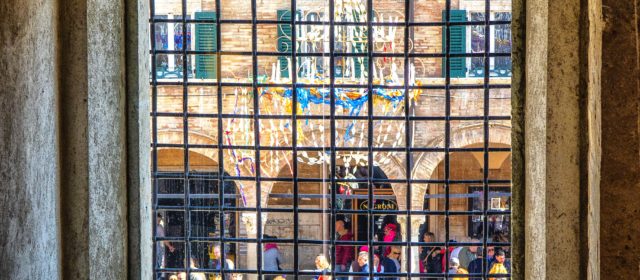Carnevale underway from the interior of the thirteenth century Palazzo dei Capitani on the Piazza del Popolo in Ascoli Piceno THE FACES OF CARNEVALE It has been Carnevale time in Ascoli Piceno. In the U.S., the New Orleans celebration of Mardi Gras is another iteration of raucous celebration that may have its roots in ancient, pagan celebrations in anticipation of the arrival of spring. Not long after Christianity made the transition from a persecuted religious sect to become the State Religion of Imperial Rome, the hierarchal structure of the Roman Christian Church was essentially all that was left of a coherent organization after the fall of Rome to the invading Teutonic hoards from the north. In time, the secular power of the Roman Christian Church continued to increase to the point where even the structure of the civil calendar was determined by the Vatican. It is a curious artifact that with all its power, the Roman Christian Church was not able to eliminate what appears to be an even more ancient joyful rite of abandon speculatively suggesting, sensual indulgence in anticipating seasonal change – what we know today as Carnevale or Mardi Gras. The most the church was able to do was to push Carnevale ahead of the pre-Easter observance of Lent. Nothing could be more antithetical to the theme of Lent in which the faithful needed to display penitence and a devotional need for redemption from the sins of indulgence in the deadly vices. During Carnevale, no self-denial here. Restrained decorum and displays of humility – not anywhere to be seen. There is so much in Carnevale and Mardi Gras symbolism that is clearly much closer to pagan sensuality than Judeo-Christian piety. There may be some connection with some of the more sensual and ribald themes seen in Carnevale with ancient springtime associations with fertility. In some respects, the underlying curious duality that exists in Italian culture is illustrated by the contrast between the public piety on display during the observance of Easter and the self-abandoned sensuality inherent in Carnevale. Culturally, many Italians identify themselves as Catholics. But under the surface, the Italian indifference to hierarchical authority comes to the surface and spills over in unabashed self-indulgence that is...
Read MoreRecent Posts
Archives
- March 2024 (1)
- January 2024 (1)
- October 2023 (1)
- November 2022 (1)
- July 2022 (1)
- February 2022 (1)
- January 2022 (1)
- October 2021 (1)
- June 2021 (1)
- March 2021 (1)
- October 2020 (2)
- September 2020 (1)
- March 2020 (1)
- January 2020 (1)
- December 2019 (1)
- September 2019 (2)
- May 2019 (1)
- March 2019 (1)
- January 2019 (1)
- December 2018 (1)
- November 2018 (1)
- August 2018 (2)
- February 2018 (3)
- December 2017 (1)
- November 2017 (1)
- September 2017 (1)
- May 2017 (1)
- January 2017 (1)
- December 2016 (3)
- October 2016 (2)
- August 2016 (2)
- May 2016 (2)
- March 2016 (1)
- February 2016 (2)
- January 2016 (6)
- December 2015 (3)
- September 2015 (1)
- August 2015 (1)
- July 2015 (1)
- May 2015 (2)
- February 2015 (1)
- January 2015 (1)
- December 2014 (1)
- November 2014 (1)
- October 2014 (1)
- September 2014 (1)
- August 2014 (3)
- July 2014 (1)
- June 2014 (1)
- April 2014 (7)
- March 2014 (7)
- February 2014 (2)
- January 2014 (9)
- December 2013 (3)
- November 2013 (13)
- October 2013 (9)
- September 2013 (1)
- August 2013 (12)
- July 2013 (15)
- June 2013 (2)
- May 2013 (2)


Recent Comments